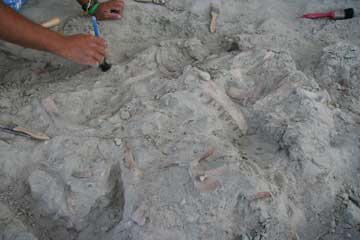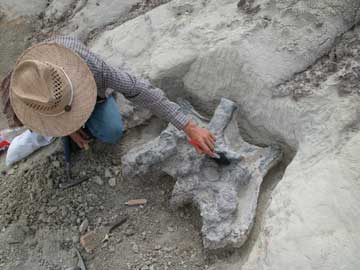|
Trends and Innovations
More Digging Ahead to Unlock Dinosaurs’ Pasts
David Williams
 |
| In 2005, researchers, seen here and below, uncovered the remains of several dinosaurs in this bonebed in northern Madagascar. The dinosaurs appeared to have died en masse during a drought. Finding such large bonebeds helps researchers figure out potential biases in the fossil record. Photo above is courtesy of Raymond Rogers. Photo below is courtesy of Robert Sullivan. |
 |
“We are currently living in a dinosaur renaissance,” says Steve Wang, a statistician at Swarthmore College. Consider that in 1990, paleontologist Peter Dodson estimated that between 900 and 1,200 genera of dinosaurs once roamed the planet. Sixteen years later, in a paper published Sept. 5 in Proceedings of the National Academy of Sciences, Dodson and Wang estimated dinosaur diversity at 1,850 genera. They account for the change two ways: better statistical analysis and more dinosaur discoveries. “We feel we’ve gotten closer to uncovering the true story of dinosaur diversity,” Wang says.
Wang notes that in the past two decades alone, paleontologists have described about as many dinosaurs as have been described since 1824. For the past 16 years, 14.8 new genera have been named per year, bringing the total number of groups of dinosaurs to 527, up from 285 in 1990. Many of the new dinosaurs come from China and Argentina, as well as Mongolia and the United States.
This marks a fundamental change in dinosaur paleontology, says Matt Carrano, curator of Dinosauria at the Smithsonian Institution. No longer is it an exclusive field where Western researchers explore their own backyards and perhaps dabble in more exotic places. Now, paleontology occurs worldwide with Western scientists teaming up with local scientists in locations such as Madagascar and Malawi — yielding exciting new finds by the month that are reshaping scientists’ views of the infamous ancient beasts.
Greg Erickson, a paleobiologist at Florida State University, seconds Wang’s observation that dinosaur paleontology is in a golden age. He credits the resurgence in the field to a new breed of scientists who combine interests in disciplines such as geology, engineering, ecology, anatomy and physiology. “These integrative biologists bring a completely different approach to the field,” he says. “We are finally bringing dinosaurs to life.”
Erickson’s recent work, for example, has focused on population biology in North American tyrannosaurs. In July 2006, he and colleagues at Florida State and the University of Alberta reported on 22 Albertosaurus individuals from a 1910 dig in Alberta. The 70-million-year-old fossils, found along an ancient riverbank, showed that if an Albertosaurus made it past the age of 2, it had a good life, with annual mortality of only 3.5 percent. In this case, size mattered, and being bigger and toothier than anyone else gave the young tyrannosaurs a big advantage.
After puberty hit, however, mortality shot up to nearly 23 percent per year. With such a decline, researchers were not surprised to find that the oldest Albertosaurus was a lone 28-year-old, which had outlived its next oldest relative by four years. Additional evidence from Tyrannosaurus, Gorgosaurus and Daspletosaurus specimens show a similar pattern.
“This was a real mid-life crisis,” Erickson says — “life or death.” He chocks it up to sexual maturity. Males begin to fight. Females devote time and energy to laying eggs and protecting them.
Although battles for sex are not uncommon, the tyrannosaur survivorship curve is not like that of any living animal, nor is the growth curve for other dinosaurs Erickson has studied, such as Psittacosaurus. He says that researchers initially thought that dinosaurs had the physiology of scaled-up reptiles, but with the advent of the bird-dinosaur connection, paleontologists looked to birds to understand how dinosaurs grew. Now, they think that dinosaurs are somewhere in between, but not aligned with, birds, reptiles or mammals. For example, the giant sauropod Apatosaurus was the fastest growing terrestrial animal ever, adding 6 pounds a day, but that rate is still slower than the fastest growing birds and slower than blue whales, which are the fastest growing animals ever measured.
Erickson’s work also accounts for a persnickety aspect of tyrannosaurs that has puzzled paleonotologists: a lack of juveniles in the fossil record. The answer is surprisingly simple. Most didn’t die during that time of life, he says.
Such a simple answer, however, may not exist for specific questions about most dinosaurs. One of the great problems in the field of dinosaur paleontology is that 59 percent of recognized genera are known from just a single individual and an astounding 80 percent of species are single individuals.
These gaps are due in part to the incompleteness of the fossil record, as well as to how dinosaurs were collected in the past, when teams would dig up only one or two individuals. In the modern paleontological world, where multiple individuals are key to understanding biology, this could lead to a change on digs, where researchers have to dig over and over again to get enough variety.
Already, Erickson notes that paleontologists are conducting more digs for biological study only. For example, he points to Jack Horner, curator of paleontology at the Museum of the Rockies, who recently said his team has exhumed more than 100 psittacosaurs in the Gobi desert this year as part of a population study.
Paleontologists are also relying on new technology to interpret their new finds. John Hutchinson of the Royal Veterinary College in London used a computer model to show that a top speed for Tyrannosaurus rex was 40 kilometers per hour (25 miles per hour), with 16 kilometers per hour more typical, in contrast to the 72 kilometers per hour previously proposed. Emily Rayfield at the University of Bristol and her colleagues used a CT scan to show that Allosaurus packed a bite more akin to a wolf than to T. rex, which probably led the smaller Allosaurus to feed more like a Komodo dragon — rapid slashing — than its bone-crunching cousin.
“Our knowledge is probably better than it should be because dinosaurs are so interesting,” Carrano says. Their large size and inherent charisma has made dinosaurs a longtime favorite of paleontologists, at the expense of other fossil animals and plants, many of which are virtually unstudied. “There is still a difficulty because dinosaur physiology is different than any living animal, but we are now able to talk in a more informed manner,” he says.
Many unanswered questions remain, however. Carrano puts the lack of knowledge in two categories. First, researchers are involved in studying aspects of dinosaurs that they know little if anything about, such as color, reproduction, metabolism and social behavior. And then there are areas in which researchers think they know a lot, but could know more, Carrano says. A prime example is extinction. The western United States has so many good, well-dated fossil sites that paleontologists can speak knowledgeably about the specific timing of extinction, he says. But elsewhere, so few examples exist that no one can say whether dinosaurs went extinct at the same time everywhere on Earth. As with all other aspects of dinosaur paleontology, more specimens will help answer more questions.
Oddly, number crunching has been able to supplement this lack of data in answering one of the big questions about dinosaur extinction. In their study, Wang and Dodson used a relatively new statistical analysis, called an abundance-based coverage estimator, to show no decline in dinosaur diversity in the last 10 million years of the Cretaceous. This contrasts with previous studies reporting a steady decline, which resulted from sampling bias, Wang and Dodson wrote. The new data is therefore consistent with the theory that a massive meteor impact snuffed out the dinosaurs 65 million years ago.
Wang and Dodson’s work offers one final caution. They estimate that by the year 2148, scientists will have found 90 percent of all genera. Dinosaur paleontologists may be in golden age, but it may not last long — so get digging now.
Williams is a Geotimes contributing writer based in Seattle, Wash.

 Subscribe
Subscribe

